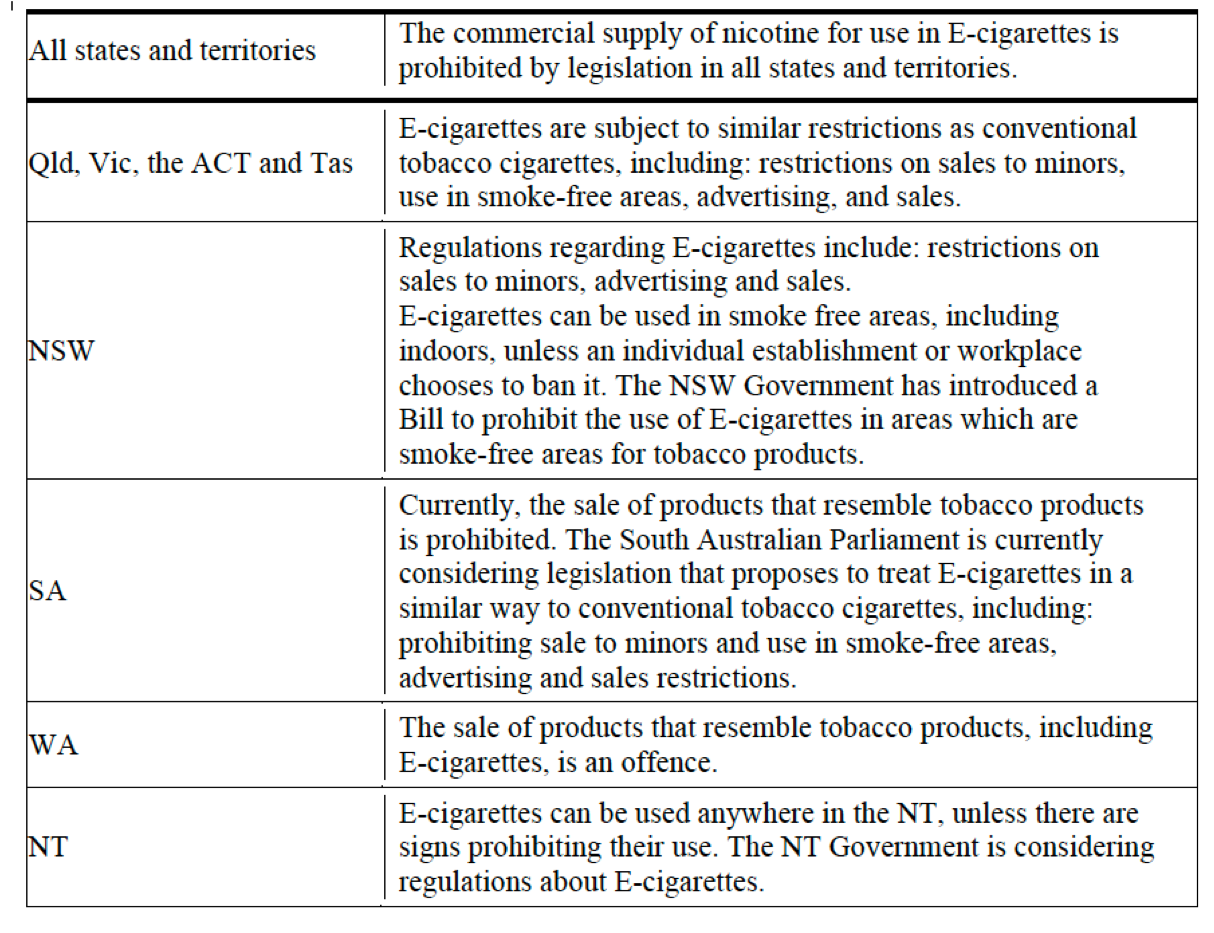Vaping, so called when smoking e-cigarettes, was conceived to quit tobacco smoking and reduce harm. However, there are rising concerns on the health risks associated with e-cigarettes, their rapid consumption by the youth, and the conflicting debates on how to address the legislation regulating their production and sale.
In the US, the detrimental consequence of vaping is being seen as a true epidemic. A recent letter published in the New England Journal of Medicine reported that within only two months there was an outbreak in severe, vaping-related pulmonary disease, increasing from almost zero at the end of July 2019 to 908 confirmed cases in September 2019. This is a phenomenon of disturbing proportions with many cases of pulmonary disease likely remaining underreported.
Recently, the acute problem on the health risks of vaping made international news with the death of 8 people in the US. It was soon revealed by the Food and Drug Administration, FDA that these men died of a mysterious “lipoid lung disease” (fat in the lungs) causing pneumonia. Some of these e-cigarettes contained the psychoactive compound of cannabis, THC, and not nicotine. Lipoid lung disease has not been reported outside the US, including Australia where nobody thus far has died from using e-cigarettes.
What are e-cigarettes? And how do they work?
Originally designed to quit tobacco smoking, e-cigarettes are mostly produced by the tobacco industry as an alternative to cigarettes. E-cigarettes are made to deliver nicotine in a controlled, safer manner with a method similar to smoking traditional cigarettes. All e-cigarettes are battery operated devices with an atomiser and a fluid cartridge. They contain a liquid mix that is heated to produce a mist inhaled into the lungs. They are supposed to have fewer toxic ingredients compared to tobacco cigarettes, which contain thousands of chemicals including approximately 80 considered cancerous in humans.

The chemicals in vapour, unknown toxicity
What are the causes of severe lung disease related to e-cigarettes? A review article analysing 64 research studies, reported robust evidence indicating how e-cigarettes may cause acute pathological lung function by inducing tissue inflammation and oxidative stress. Apparently, these detrimental effects are less harmful compared to traditional cigarettes.
Which are the compounds in question?
Besides nicotine delivered in varying concentrations, water-soluble vaping liquids may include propylene glycol, glycerol, formaldehyde, acetaldehyde, acroleine, propanal, acetone, o-methyl-benzaldehyde, and carcinogenic nitrosamines plus flavouring substances. One of these is diacetyl, an additive with a pop-corn flavour, likely responsible for a serious/irreversible lung disease called bronchiolitis obliterans (an inflammatory condition of the lung’s bronchioles leading to extensive scarring that blocks the airways). An additional problem is the use of black-market vaping products of unknown composition and quality.
Which are the mechanisms leading to lung disease?
When reaching the deep structures of the lung, these chemicals display their toxicity to cells by increasing the production of mucus and stimulating inflammation as well as the activity of tissue-degrading enzymes, named proteases, which break-down proteins, irreversibly destroying lung tissue. These processes can also lead to other lung diseases such as chronic obstructive pulmonary disease (COPD) and are particularly dangerous to people with existing chronic lung conditions such as asthma.
Research studies from the University of Birmingham in the UK, show that the e-liquid vapourised through e-cigarette disables the protective function of the lung immune cells, called alveolar macrophages. Alveolar macrophages remove dust, destroy bacteria and allergens reaching the respiratory tract. The researchers suggest that because of these pathologic effects e-cigarettes may be more harmful than we think.

Cannabis e-cigarettes
In contrast to liquid-nicotine e-cigarettes, cannabis e-cigarettes are oil based, having unknown and uncontrolled substance quality and quantity. Contaminants such as pesticides, fungi and heavy metals have been detected in vaping fluid. Vitamin E oil, used to dilute and thicken the cannabis vaping liquid, seems to be harmful as well. However, the health risks of all these chemicals remain to be elucidated and are difficult to determine given the variability of compounds used and the obstacles of testing.
The American market and the youth problem
The sale of any electronic nicotine delivery systems (ENDS) in the US is legal as shown on the FDA website, and the US the dominating country in the global market of e-cigarettes. The sale of e-cigarettes has grown steadily from US$ 19 million in 2011 to US$ 409 million in 2017. The most recent spike in sale occurred in 2017 and is driven exclusively by a new product, JUUL. The company, JUUL is not directly owned by tobacco companies but is strictly interconnected through its major investor, the Altria Group, formerly Philip Morris Companies. Within the last few years, JUUL rapidly became the largest brand of e-cigarettes with annual sales over US$ 650 million, covering over the half of the entire e-cigarette market in the US.
JUUL is an attractive, tiny high-tech device consisting of a flat, portable device similar to flash drive to be recharged via a USB port. JUUL products are increasingly popular among young groups because of their look and the availability of sweet, aromatic flavours particularly targeted for, and appealing to this young community. It is estimated that 3.6 million students used e-cigarettes in 2018. JUULs contain nicotine salts extracted from tobacco leaves packed into disposable cartridges. They seem to have a higher nicotine concentration, consequently delivering a peak effect within minutes. The worrying problem is that young people take up JUULs before having ever smoked tobacco cigarettes, and thus these devices are suspected to function as a vehicle to tobacco smoking. This is in fact, the exact contrary to their primary purpose as outlined on their website to: “Improve the lives of the world’s one billion adult smokers by eliminating cigarettes”.

Vaping in Australia
The Australian laws concerning e-cigarettes are complex, vary between jurisdictions and are strictly regulated.

The supply as well as the possession of nicotine-containing e-cigarettes in Australia remain illegal. Even the sale of non-nicotine e-cigarettes is illegal in some states. In most states and territories, it is forbidden to smoke e-cigarettes in places where smoking is not permitted.
Despite these barriers, the use of e-cigarettes by Australian smokers has increased over recent years. Generally, prior to becoming legal, the Therapeutic Goods Administration,TGA must approve nicotine and non-nicotine-based e-cigarettes. However, because nicotine is classified as a poison, any device containing nicotine is currently not permitted.
The reasons behind these restrictions in Australia is because the evidence around their utility in smoking cessation is considered insufficient by the National Health and Medical Research Council. Also, the potential health hazard of e-cigarettes remains unclear with recent deaths in the US raising further concerns.
Vaping occurs in about 1.2% of the Australian population and to date no cases of vaping-related lung disease have been reported. Although nicotine-containing e-cigarettes are banned in Australia, there is an illicit market for these products coming from overseas. However, some people will vape nicotine-free products as an alternative to smoking.

There are concerns that a growing e-cigarette culture in Australian teenagers will lead to an increase in combustible cigarette smoking. In fact, 13 per cent of Australian teenagers have had already tried e-cigarettes.
Evidence of e-cigarettes help quit tobacco smoking
We are unable to estimate the risk to benefit ratio of tobacco versus e-cigarette smoking. A recent study published in the New England Journal of Medicine in February 2019, recruiting 900 participants in the UK, clearly showed that those using e-cigarettes where twice as likely to stop tobacco smoking within a year compared to aids like nicotine patches and gums.
International position on vaping
The World Health Organisation (WHO) Framework Convention on Tobacco Control, a global public health treaty including Australia, encouraged a precautionary approach to e-cigarettes in response to the lack of evidence of safety, the potential risks to users and non-users, the lack of evidence of effectiveness in smoking cessation, the concerns about use by children and non-smokers and the potential for undermining of tobacco control efforts.
The British American Tobacco Australia quoted a section from the WHO, stating: If the great majority of tobacco smokers who are unable or unwilling to quit would switch without delay to using an alternative source of nicotine with lower health risks, and eventually stop using it, this would represent a significant contemporary public health achievement.
In Europe and the United Kingdom e-cigarettes are strictly regulated by the Tobacco Products Directive (TPD) whereby nicotine-e-cigarettes must be notified and only allowed with a maximum nicotine concentration, leak proof containers, on-pack health warning, quality standards for ingredients and the removal of products that do not comply.
Lawsuits targeting vaping
In the US, a tsunami of lawsuits has been filed to target vaping, mostly targeting JUUL. Most plaintiffs claim that they became addicted to e-cigarettes like JUUL. Other topics raised against JUULs in these lawsuits include the fraudulent marketing and product liability. An investigation launched by the United States House of Representatives found that: “JUUL appears to be violating FDA regulations against making unapproved express and implied claims that its product helps users stop smoking cigarettes and is safer than cigarettes”. Due to these serious legal challenges, JUUL may require to lay-off of hundreds of employees in the near future.
In summary the lawsuits launched in the US mainly revolve around the following issues:
* Young adult JUUL users and parents of teenage users have filed dozens of lawsuits against JULLs; both individual lawsuits and class actions over vaping-related injuries in courts around the country.
* Most of the plaintiffs allege that users became addicted to JUUL and occasionally caused health harm such as stroke and seizures.
* Fraudulent marketing, accusing JUUL of claiming its e-cigarettes help adults stop smoking, while marketing them to minors and young adults who have never used nicotine. They also say JUUL can deliver higher doses of nicotine.
* Product liability, JUUL products are defectively designed.
Concluding remarks
Australia cannot be compared to the US regarding the magnitude of the e-cigarette market, the number of consumers, the growing epidemic of people with severe lung conditions or deaths and the mounting lawsuits lodged against the e-cigarette producers. But there are some lessons we can learn from the American reality.
Vaping confronts us with a number of issues, from the yet undefined health risks of the substances utilised in the vapouring liquids, to the complex strategies to regulate their production, marketing and usage. A grave problem is the consumption of cannabis e-cigarettes, which cause a far greater health-hazard, and finally the uncontrolled black market that escapes testing, thus bringing unknown risks to the users. It is also paramount to protect adolescents and younger adults as they are more vulnerable to accept aggressive marketing through social media and their higher susceptibility to early nicotine addiction. Globally, more research is warranted before e-cigarettes can be safely recommended to people willing to stop smoking.
In conclusion, it may be wise to follow the quote of the UK Department of Health’s tobacco Control Plan for England:
The best thing a smoker can do for their health is to quit smoking. However, the evidence is increasingly clear that e-cigarettes are significantly less harmful to health than smoking tobacco. The government will seek to support consumers in stopping smoking and adopting the use of less harmful nicotine products.
